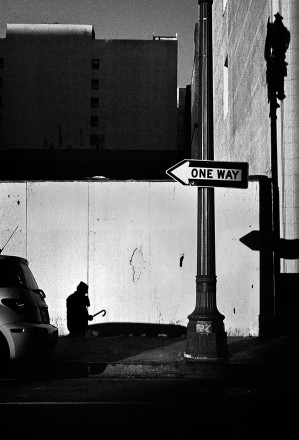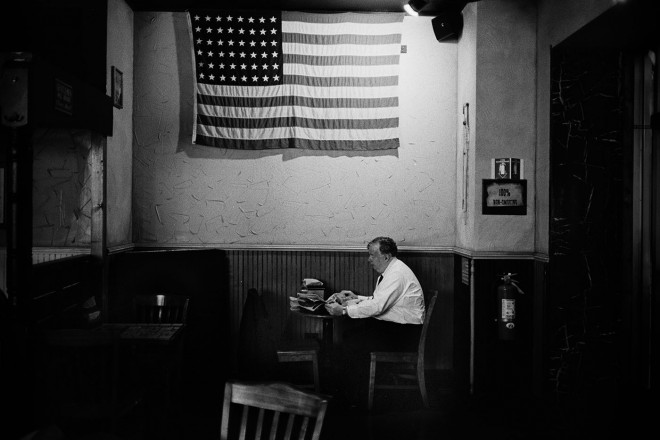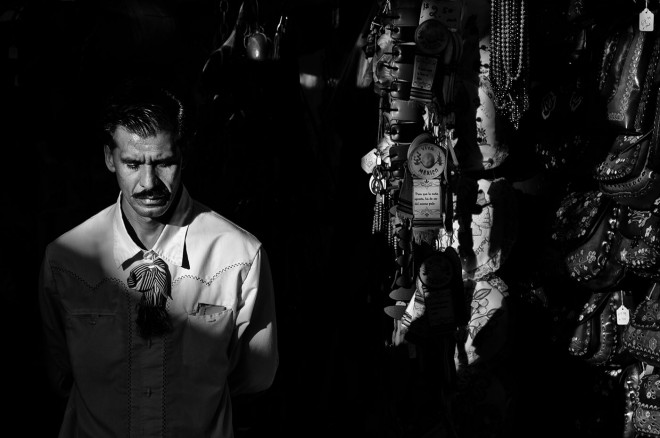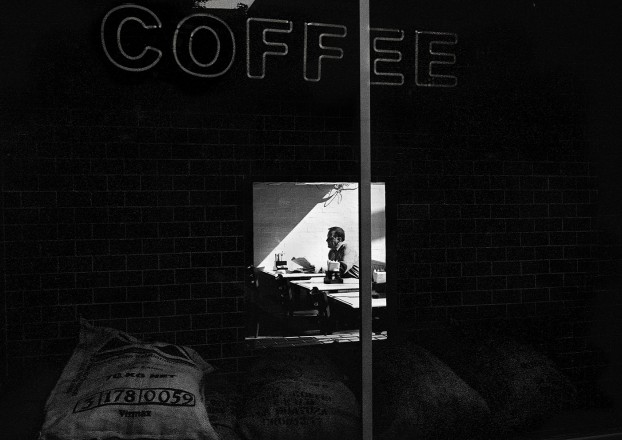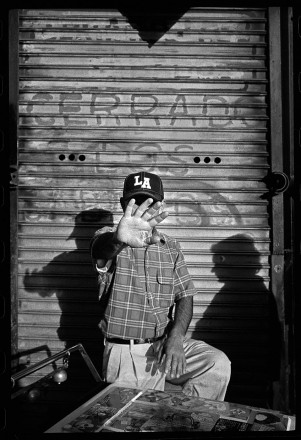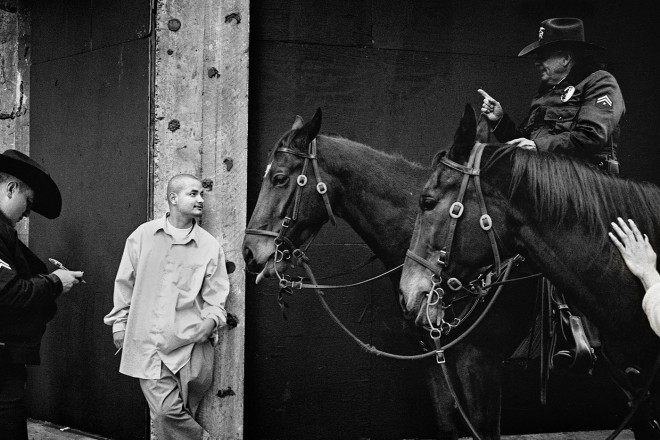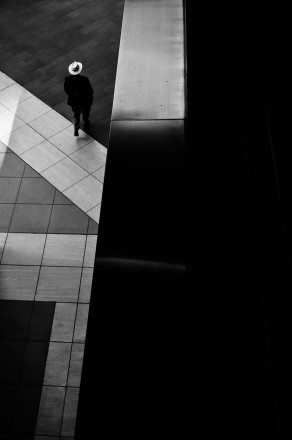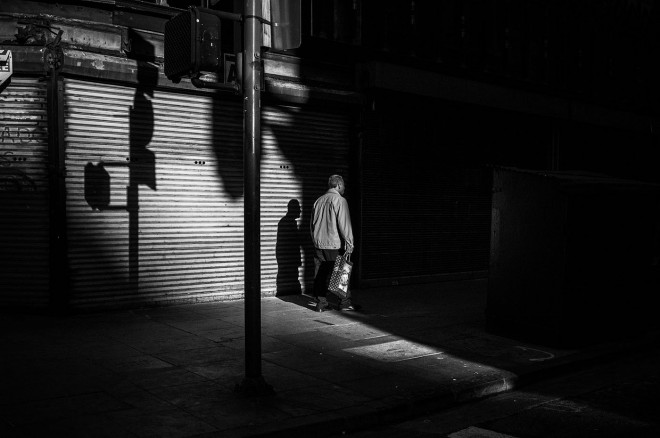Conversations in Light: Street Photography
Rinzi Ruiz and Dana Barsuhn are street photographers based in Los Angeles. One shoots film and the other digital, but they both share a passion for downtown and the way that light illuminates and transforms the buildings and the characters that abound there. Though they each have their own unique approach to photography, they share a common passion and respect for how light allows them to create their distinct imagery.
DANA BARSUHN
www.danabarsuhn.com
A Southern California native, Dana lives and works in the Los Angeles area. When not serving clients, or hanging out with family, you will often find him walking the streets of Los Angeles capturing life as he sees it in black and white.
RINZI RUIZ
www.rinziruizphotography.com
Rinzi is a photographer who’s passionate about capturing the moments in life. He finds beauty in humanity by capturing the emotion, the mundane, and the art in reality that’s found everywhere. He has been featured in Los Angeles Times Framework and a few street photography blogs—such as The Candid Frame, Fotoflock, and visuelleGedanken for his street photography work—but also is involved in other types of photography, such as portraiture, events, and weddings.
Rinzi, in the time that I’ve been following your work, the way you use light has really changed. Why don’t you share how you see and use light now as compared to several years ago?
Ruiz: A couple of years ago, there were still things that I was trying to figure out—technical stuff. I had just bought a lot of fast glass and was shooting at f/1.4 much of the time, but I wasn’t really paying attention to where the light was coming from. So, as soon as my brain caught onto the idea of paying attention to where the light was coming from, it really changed how I saw everything.
And it seems that shadows became particularly important in your work.
Ruiz: Yes, because as soon as I started checking out where the light was coming from, I became sensitive to how the sun illuminated things that I wanted to show, and the shadows could hide stuff that I thought was clutter. It was kind of an epiphany: Figuring out that it could really clean up my composition if I could just hide stuff in the shadows.
How about you Dana?
Barsuhn: About 2 to 2 1/2 years ago, I started doing a “365 project,” as part of an online community where I was challenged to make photographs every day. While doing this, it was hard not to look at light more; otherwise, my images were going to start looking exactly the same. It was interesting that, especially on those days when it was raining or cloudy, I began to notice the quality of the light more. This was also a time when I was shooting more on the street and, with all these big buildings around, it brought in a whole new quality of light for me. A lot of that came from moving from sunlit areas to shaded areas and, when the sun started shifting, all of a sudden I started to notice reflections. I remember when I first saw these little pockets, I’d look around, trying to identify where they were coming from. Now when I’m out, I look for those things. Of course, that’s not to say that those are the only things I look for, but when I do see something like that, I’m more apt to wait for something to happen in that light.
You have both shot in downtown Los Angeles, by yourselves and together. So, what is it about the quality of light in this particular part of the city that keeps drawing you back?
Ruiz: Venice and Hollywood, for example, don’t have the collection of tall buildings, which allow shafts of light to come through, that downtown L.A. has. So, downtown is definitely ideal, especially down Broadway and the older areas, where the old buildings have so much character. It allows me to create a photograph that seems timeless. I can create images that could have been shot now or sometime in the past. I really like images that spur people to ask, “When was this shot?”
Barsuhn: Yeah, Rinzi touched on the kind of diversity and the character that exists there, especially when you think about Spring Street or Broadway, where there’s such juxtaposition between the buildings, the people, and the history that surrounds the area. Within in a half-mile radius, you have an arts district, a business district, Chinatown, and the fashion district. In one day, you could hit every one of those spots and never get bored. The only thing you’ll need is a new pair of shoes, because you’re going to wear out their soles.
And the amazing thing is how the light can change.
Barsuhn: Yeah, during different times of the year, even month to month, you can be at the same spot at the same hour, and you’re not going to get the same quality of light as you did the month before. I was just out shooting yesterday, and at this time of the year the sun isn’t as high as it was during the summer. So, you’re getting a different quality of light all day long.
That’s really an important point. The more you return to a specific area, the more sensitive you become to those changes of light that occur throughout the year. It’s not just the weather, but also the position and direction of the light relative to what you’re shooting.
Ruiz: Yes, for example, during the summer I shoot until 7, maybe 8 o’clock, but during the winter, the sun has already gone away at 4 or 5 o’clock. The angle of the sun and the way it touches and reflects off the surface of a building become completely different. What I really like about photographing on the streets is how random it is, and that’s the challenge. The light is constantly changing. People are constantly moving. So, the challenge for me is to create a frame where all those things come together. Ultimately, I just need to be ready for those moments where the light, the subject, and the background meet. If I’m there and I’m ready, I’m good.
Could each of you walk me through an example of when you found the light, and how you built a photograph from there?
Barsuhn: Like Rinzi just said, it’s a matter of just being prepared. When I’m walking down a street, I’m thinking about which direction the light is coming from. If the light is directly facing me, I know that I’m not likely to take a photograph of someone coming toward me, unless I make the choice to expose for the shadows and really blow out the background. Or, maybe I’ll turn around so that the sun is at my back and illuminating people’s faces.
So, you’re thinking as much about exposure as you are your subject.
Barsuhn: Even before I’ve discovered a subject, if I know my subject is going to be illuminated by the sun, I make sure to expose for the highlights. And, when I’m in an area that’s mostly shadows or shade, I’m already preparing to shoot a proper exposure for that kind of light. When I do see a subject, then I’m not fiddling with my camera, trying to figure out what exposure I should be at. I shoot with a manual-focus, rangefinder camera, so I’ll also prefocus my lens knowing that I’m going to be a certain distance from that subject to take the shot. I’m kind of locked and ready.
Ruiz: Well, I shoot with a digital camera, but I still work to keep my settings the same. Once I see the quality of the light, I’ll set up my ISO, shutter speed, and aperture.
You guys have actually shot together. So, what observations do you take away from watching each other shoot, especially with respect to how the other person uses light?
Ruiz: What I take away from Dana is the care he takes with his framing. How he’s patient and really waits for the shot. I’ve watched him a few times where he’ll just stand there for a second and observe. He’ll prepare his camera for that particular lighting situation, he’ll wait, and then just pounce.
Barsuhn: First off, Rinzi walks around so much that, given the time of year, he knows where the light’s going to be. I’m sure that he has some kind of matrix in his head that tells him where all the different shafts of light will be at any given time and location. He probably has a map in his house! I’m joking, but it’s amazing how he’s already ahead of himself as far as where he’s going and where the light is going to be. He does a lot of the waiting game as well, and that’s where he’s able to capture some of his amazing compositions.
That’s especially true when you think about how he builds compositions around those shadows.
Barsuhn: Some people may wonder how Rinzi gets those shots but, after shooting in downtown for so long, you’ll begin to understand that, by looking at a scene, you know where the light is going to fall and where it’s not. I think that’s kind of the key to this whole lighting thing. It comes down to understanding that our eyes see a much wider dynamic range than our cameras do. So, if you shoot enough and you make enough images, you start to learn to see the way that the camera does. Rinzi has that eye and he can visualize how the camera is going to see that scene.
Is there anything that you consider to be “bad light,” the kind of light where you won’t even bother shooting?
Ruiz: For the photography style that I like to shoot, I definitely prefer it to be sunny. We’re lucky in L.A. that we don’t have a shortage of sun. It’s funny, however, that when I travel, I frequently find myself shooting in situations where it’s overcast most of the day. On recent trips to New York and Japan, I wanted to get some really good images, but it was mostly overcast in both places. When it’s overcast, I can’t shoot the way that I like, but it doesn’t mean that there’s no light coming from somewhere. So I just have to adjust and change my shooting style. On such days, I may spend more time shooting portraits.
Barsuhn: Growing up in Southern California, we’re just used to the sun always being out. And when it’s not, it kind of throws us off. But I also believe that it’s a great learning experience because when it’s overcast or raining, it gives us an opportunity to experience a different quality of light. It changes textures and it changes the relationship between highlights and shadows. I think that’s crucial for us, not only as street photographers but also for all the other kinds of photography that Rinzi and I do for clients. When you’re working for a client, it’s not always going to be a bright, sunshiny day, and understanding what those qualities of light can bring become invaluable.
When you look at other photographers’ work, what common mistakes do you see with how they perceive and use light?
Ruiz: I’d say that when you’re not using light and paying attention to the shadows, your images tend to look flat. That doesn’t mean it’s a horrible image or that the photographer didn’t catch the moment, but it could have been enhanced if they’d made better use of the light.
Barsuhn: I think it’s especially an issue when they’re looking for a specific subject and just photograph it without thinking about the light. Part of what I, and others, do is get into a position where I can get a quality of light and use it to capture that scene or subject eloquently.
Rinzi, you’re primarily shooting digital and Dana, you’re using film. Why did you choose that particular medium, and what differences does it make, not only in the look of your pictures, but the way you create them?
Barsuhn: There’s always a debate about this. To be honest, if I could have afforded a digital rangefinder years ago, I’d probably be shooting digital. But I’ve actually fallen in love with film now. It’s not so much the aesthetics of it, or what it looks like, or any of that. For me, it’s much more about the process. You can achieve similar results with digital, but I think it’s the subtle nuances that force you to visualize a little bit more. I push my film quite a bit, so I know I’ll lose a little bit of detail in the shadows; however, this lends itself to the kinds of images that both Rinzi and I make, where we’re exposing for the highlights and creating much deeper blacks.
Ruiz: I haven’t shot a lot of film, but I can see why people are drawn to it. I prefer digital because it provides the opportunity to learn a lot, especially from my mistakes. What’s that saying? “Your first 10,000 photographs are your worst.” With digital, it’s probably your first million shots. You shoot so much more, and you become willing to experiment, and that’s exactly what I did. I try to understand any cameras that I’ve ever had, and shoot with them as often as possible.
Barsuhn: On the topic of gear, I’d like to point out that Rinzi also takes a lot of images with his phone, and his Instagram images are well known. He has some amazing iPhone pictures that he edits and puts on Instagram that are just as good as the images he creates with his Fuji X-Pro1 and X100 or my Leica rangefinder. What makes them amazing is his vision and how he sees the light.
What would you suggest to a photographer who wants to learn how to better use light in their photography?
Ruiz: I think it’s just being willing to look at the world and the light differently. It’s about giving yourself permission to see differently than you do now. So, when you finally get “that shot,” you know what it really means, and your entire way of shooting will change after that.
Barsuhn: I started shooting digital way before I started shooting film, and I realized that the EXIF data was invaluable. Therefore, my suggestion would be to go out with just one camera and one lens, shoot with them for a couple of weeks, and see what you come up with. Then, when you find some good photographs, look at your data, and discover where you were at technically.
Working with light is an essential element to your photography. How you use light creates a unique stamp on your images. How you edit them does as well. If you use Lightroom to edit your images, Scott has a Keyboard Shortcut for you in this Lightroom Killer Tips article. For more inspirational conversations, check out the incomparable Jay Maisel in this interview.

